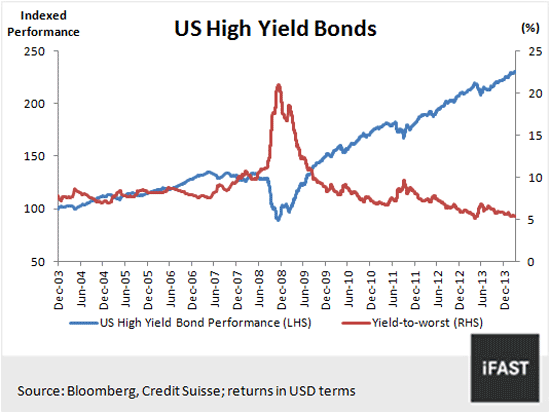Higher returns in US$ fixed income bonds
Post on: 13 Июнь, 2015 No Comment

Story Created: Jul 27, 2014 at 11:07 PM ECT
Story Updated: Jul 27, 2014 at 11:07 PM ECT
Today, we at Bourse review the international fixed income markets and consider events for the first half of 2014. We explore how investors may achieve annual bond returns in the range of 4-6 per cent over a 5-7 year period through investing in emerging market fixed income instruments, using a hold to maturity approach. This strategy is particularly rewarding when considered in the context of a persisting low interest rate environment for TT dollar and US dollar investments.
Exhibit 1 illustrates the commendable performance of emerging market bonds in comparison to other asset classes for 2014 thus far.
Note: Total return refers to capital appreciation plus distribution (dividends or coupon payments).
US Fed maintains policy direction
The major event for global fixed income markets remained the Federal Reserve’s continued reduction of its Quantitative Easing programme, from US$85B in bond purchases per month to US$35B as at June 30th given an eventual end in October 2014. While expectations were for bond prices to be negatively impacted, prices have remained resilient for 2014.
The US economy experienced a 2.9 per cent contraction in Q1 GDP against the backdrop of severe winter conditions, which hampered economic productivity during the period. In Q2, increased private sector demand, led by positive manufacturing data, coupled with promising employment statistics highlighted the prospect of economic expansion for the remainder of the year. While economic data remains mixed, conservative investors have kept faith in US treasuries, which have gained 3.3 per cent for 2014 thus far.
Emerging Market bonds lead
After a mixed 2013 performance, Emerging Markets bonds have been the strongest performer amongst USD denominated bonds in 2014, year to date. An indifferent start to 2014 gave way to strong returns in this asset class, as illustrated in Exhibit 2. The concerns which had arisen from the initial announcement of the end of quantitative easing appears to have abated, creating the environment for a very tidy rally in EM fixed income assets.
Note: Total return refers to capital appreciation plus distribution (dividends or coupon payments).
Within the EM space, uncertainty surrounding some countries presents possible investment opportunity. Russian capital markets, in particular, have experienced a choppy first half of the year as a result of ongoing political rumblings. Following Russia’s annexation of the Crimea region, sanctions continue to be imposed on the Russian Federation through their banking and energy sectors. Yields on Russian assets have subsequently increased as prices have fallen on bonds within the BBB- (investment grade) region.
In the Brazilian space, following a successful World Cup (in terms of hosting!), the country now returns to the realities of economic management. Mixed economic performance will play second fiddle to the major market moving event of this South American giant, the upcoming October 2014 Presidential elections. Whether there is a change in administration or not, the government is expected to implement policies with a focus on economic growth which has already led to increased investor confidence.
A more rewarding USD investment
This year, thus far, has seen international investors global investors pour into emerging market bonds. Local investors also have, through investing in international fixed income, a more rewarding income-generating alternative to parking USD cash in USD money market mutual funds (with annual average return of 1.09 per cent locally) or bank accounts, which earn less than 0.25 per cent per annum. Exhibit 3 depicts the benefits of investing in USD Emerging Market bonds with a 5-7 year maturity from either speculative grade or investment grade, as compared to the average US money market rate.
In prevailing market conditions, emerging markets can give the fixed income investor an opportunity to attain a substantial of yield pickup of 3.4 per cent — 3.9 per cent and 4.0 per cent — 4.9 per cent on investment grade and speculative grade bonds respectively, over and above local USD money market rates.
International Fixed Income
could fit your portfolio
Investors may recall Bourse’s 2014 Investment Themes, which included:
Bourse 2014 Investment Themes
1) Target Positive Inflation Adjusted Returns
2) Lengthen your Investment Horizon
3) Diversify across Currencies
4) Diversify across Asset Classes
Emerging market fixed income presents an attractive opportunity for investors, with access to US currency, to achieve all four of these themes in their investing activities.
The menu of international bonds is diverse, catering to almost every investor’s needs. For those of a less risk-tolerant nature, investment grade bonds with a maturity between 5 to 7 years could provide annualized returns (holding to maturity) in the range of 4.5 per cent to 5 per cent.
For investors willing to take more measured risks while earning the commensurate higher return, solid speculative grade bonds with a maturity between 5 to 7 years could provide annualised returns (holding to maturity) in the range of 5 per cent to 6 per cent. Lengthening the maturity of your bond investment would also increase the annualised yield. Exhibit 3 illustrates the return potential of emerging market investment and speculative grade bonds.
International fixed income remains a good addition to an investment portfolio. With such a diverse menu of geographies, industries and debt structures to choose from, it makes sense for investors to consult with their preferred, qualified investment advisor, of which Bourse is one, when investing to the international fixed income space.
For more information on these and other investment themes, please contact Bourse Securities Limited, at 628-9100 or email us at research@boursefinancial.com. “The production of this publication is not to in any way establish an offer or solicit for the subscription, purchase or sale of the any securities stated herein to US persons or to contradict any laws of jurisdictions which would interpret our research to be an offer.














